
So much time can be spent getting all of your exploration fix in that by the time you decide to pick up the story again and finish off the last 5% to 10% of what’s left of narrative, then odds are you’ve already forgotten what’s going on. When the game finally opens up into a vast green world rife with side-quests galore is the moment when the plot comes to a screeching halt. Most of the game (like some 85% of it) is spent on purely linear routes, moving across the map toward a glowing orange symbol to encounter a boss or trigger a cinematic, barring any of the sense of adventurous exploration present in so many other examples in the franchise. Just look at this map: You might not be able to see it at this resolution but there’s a dotted line that connects the hallway on the far right back to the hallway on the far left. You might try to run or you can just walk, but either way, you’re only passing down the same hallway, endlessly. You reach the end of that hallway to find, dread as you might, another hallway… Imagine traversing these hallways for hour after hour.

Oh sure, it might have different wallpaper or a different flower soaking in a vase on a shelf, but it seems like it’s the same hallway. Imagine you reach the end of the hallway and you find that there is another, similar hallway. There are no doors or passageways that branch off. Imagine you are walking down a long hallway. “ becomes very difficult to tell a compelling story when you’re given that much freedom.” The director, Motomu Toriyama, said about the lack of open world exploration and I blockquote: The biggest complaint anyone can make about FFXIII is its infamous linearity. It might as well be in Japanese because I have no idea what I’m doing. Further, the Crystarium leveling system allows the gamer some degree of customization, letting you decide how exactly to direct your characters’ statistics. Certain members of the cast are better at different Paradigm classes, like Ravager (magic-based), Commando (physical-based) or Saboteur (insulting an enemy’s mother to inflict negative status effects, such as “Yo momma’s so fat she couldn’t fit through the narrow, linear hallways that comprise over 85% of this game”). Fear not, Paradigming does not make your characters clones of each other. The Paradigm Shift system essentially allows you to change your characters’ classes at any point in a fight, emphasizing quick strategy to attempt to “stagger” enemies, reducing their defenses and rendering them vulnerable. The graphics are most impressive, the score is worthy of Uematsu’s legacy (I breathed a sigh of relief upon hearing the pianist’s melody on the title screen), the voice acting is more than passable, the world environments are as fantastic as the title suggests, and the battles feel new, fast-paced and exciting. Our PMS-ing protagonist, who apparently has no idea how clothes work.Īll the beauty of a franchise that has consistently made nerds soil themselves since 1987 is here. Killing Orphan will result in Cocoon’s destruction and the summoning of the Maker, the creator of worlds, who will supposedly wipe the planet’s slate clean. He tells the party that their mission is to transform into the beast Ragnarok and kill the sleeping fal’Cie Orphan, who keeps Cocoon afloat above Pulse.

In the process, they uncover a plot ( spoiler) by a Cocoon fal’Cie who was masquerading as the human primarch Dysley but is actually a villain named Barthandelus. Rallying against the Sanctum, they try to discover the task assigned them by the fal’Cie and whether they can avoid being turned into monsters if they fail or crystals as their reward. Lightning is joined by many allies and together they also are marked by the same creature and become l’Cie, the fal’Cie’s puppets. Former soldier Lightning fights against the Sanctum in order to save her sister who has been branded as an unwilling servant to a god-like entity from Pulse, known as a fal’Cie.

In the dystopian society of Cocoon, the Sanctum government is ordering a purge of civilians who have allegedly come into contact with Pulse, their national enemy. That’s right, a cast just as memorable as H.R.
#Final fantasy xiii series
In step with the series’ motif of telling new stories with each entry, FFXIII follows the intersecting lives of several throwaway characters: the unlikeable, “coolness-factor” protagonist Lightning, the second-token-black-guy in the series Sazj, the blondie beau Snow, the airhead waif Vanille, the effeminate mama’s boy Hope and the mysterious sounds-like-an-Aussie-for-no-reason Fang. Our first review ever is for Final Fantasy XIII! It is the thirteenth numerical installment in the fanatically popular franchise. “Begin at the beginning,” the King said, very gravely, “and go on till you come to the end: then stop.”


 0 kommentar(er)
0 kommentar(er)
